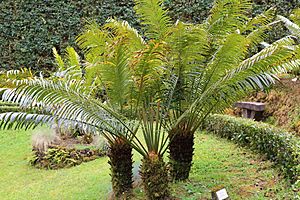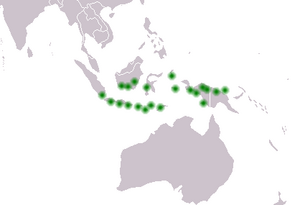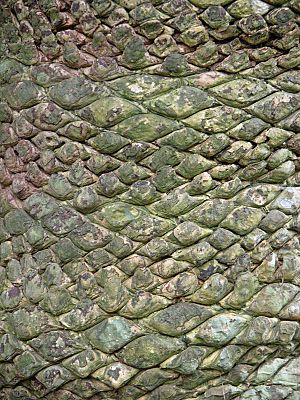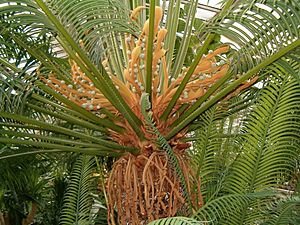Queen sago facts for kids
Quick facts for kids Queen sago |
|
|---|---|
 |
|
| Male plant with strobilus, or cone, at the Berlin Botanic Garden | |
| Conservation status | |
| Scientific classification | |
| Genus: |
Cycas
|
| Species: |
rumphii
|
 |
|
| Distribution | |
| Synonyms | |
|
|
The queen sago (scientific name: Cycas rumphii) is a special type of plant called a gymnosperm. This means it produces seeds that are not inside a fruit, unlike flowering plants. It's a kind of cycad, which are ancient plants that look a bit like palm trees but are actually very different! You can find the queen sago growing naturally in places like Indonesia, New Guinea, and Christmas Island.
Contents
What is a Queen Sago?
The name 'queen sago' helps us understand this plant. It's called 'queen' because it's related to another plant called 'king sago' (Cycas revoluta). Both plants are also used to make a starchy food called sago. The second part of its scientific name, rumphii, honors a Dutch naturalist named Georg Eberhard Rumphius. He was a scientist who studied plants and animals a long time ago, from 1628 to 1702.
How Does the Queen Sago Look?
The queen sago is a small tree that can grow up to 10 meters (about 33 feet) tall. Its trunk can be as wide as 40 centimeters (about 16 inches). The bark is grey and has cool rectangular or diamond-shaped patterns.
Its leaves are bright green and shiny, looking a lot like palm fronds. They can be very long, from 1.5 to 2.5 meters (about 5 to 8 feet), with many smaller leaflets on each one. The part of the leaf that connects to the stem, called the petiole, has spines and is about 35 to 60 centimeters (14 to 24 inches) long.
Reproduction: Male and Female Plants
Queen sago plants are either male or female. This means you need both a male and a female plant for them to make seeds.
- The male plant has a cone, which is called a strobilus. This cone is orange, smells a bit strong, and can be 30 to 60 centimeters (12 to 24 inches) long.
- The female plant has special leaves called megasporophylls. These are about 30 centimeters (12 inches) long, brown, and hairy.
The seeds are about 45 millimeters (1.8 inches) long and 30 millimeters (1.2 inches) wide. They start green and turn orange or reddish-brown when they are ready.
Where Does the Queen Sago Grow?
The queen sago mostly grows in the Maluku Islands, which are part of Indonesia. Its natural home stretches north to Sulawesi, east to New Guinea, and west to Java and southern Borneo. You can also find it on Christmas Island, which is an Australian territory in the Indian Ocean. It even grows in parts of Australia, like Darwin and Western Australia. People also grow it in places like Fiji and Vanuatu.
This plant loves tropical areas, especially coastal forests or woodlands. It often grows on sandy dunes or limestone areas near the ocean.
How Do People Use Queen Sago?
The trunk of the queen sago contains a starchy part called pith. People can dry, grind, and wash this pith to make sago, which is a food product.
The seeds of the queen sago have a natural chemical that can be harmful. However, people can treat the seeds by pounding, washing them many times, and cooking them to make them safe to eat.
Some parts of the plant, like the bark, seeds, and sap, have also been used in traditional medicine. For example, they might be used in poultices (a soft, moist mass applied to the body) to help with skin problems.
Is the Queen Sago in Danger?
Even though you can find many queen sago plants in some areas, the species is considered 'near threatened'. This means it could become endangered in the future. The main reasons for this are that its natural home is shrinking, and the number of plants is going down. Protecting these unique plants and their habitats is important!




